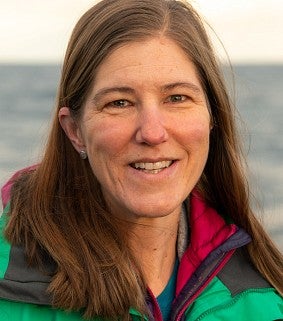Biology professor Kelly Sutherland feels like she’s won the golden ticket.
After seven years of seeking funding for her research into the swimming mechanisms of gelatinous marine organisms — or “jellies,” as she calls them — Sutherland has been awarded $1.1 million over three years from the Gordon and Betty Moore Foundation.
The grant is the largest the Moore Foundation has ever awarded to a University of Oregon faculty member. Sutherland says her journey to secure it was a long one.
“If you hope to be funded you have to keep innovating and keep making progress,” she said. “A lot of what we’ve found is unexpected. It really supports the idea that you need to do these exploratory studies and understand how things work.”
The Gordon and Betty Moore Foundation proved to be a funding match for Sutherland and her team. The foundation “fosters path-breaking scientific discovery, environmental conservation, patient care improvements and preserving the special character of the Bay Area.” It is funded through the foundation’s Science Program.
The project focuses on understanding how jellies work together to swim through the open ocean. The organisms include the jellyfish we are most familiar with but also many other creatures, such as gelatinous worms and snails.
More specifically, Sutherland is studying how salps, barrel-shaped jelly animals that feed on plankton, move efficiently through the water. Salps grow in colonies that can be made up of hundreds of individuals and can be meters long in length.
The colony moves through the collective motion of individual organisms pulsing water through their bodies, propelling them forward. These colonies, Sutherland said, are among the most effective swimmers in the ocean, capable of swimming the equivalent of a marathon every day.
“They are little pumps,” Sutherland said. “As they filter water to move, they are also filtering for food.”
Salps, and jellies in general, are not easy to study. They are fragile and can only survive in the open ocean. If they happen to wash up on shorelines, they usually just fall apart. Sutherland is overcoming this challenge by taking the lab underwater to study them.
“There’s a weirdness about things that are colonial,” Sutherland said. “It’s hard to wrap our heads around the idea of these identical clones. It’s so alien to us because that’s not how we operate.”
For the bioinspired design angle of Sutherland’s research, she seeks to better understand the colonies’ swimming efficiency by looking at everything from the shape of the colony as it moves to how the water swirls inside the body to the pattern of the water as it moves around the organism. From this information, she offers ideas for improved underwater transport.

For Sutherland, one of the most surprising discoveries so far has been the lack of a pattern of propulsion. When the jellies move in their colony, they do not all pulse at the same time. Instead, individual organisms pulse water out of sync, which actually allows the colony as a whole to maintain continuous movement.
“When you pulse, you move forward, but then you have to stop and refill, so you slow down. Then you have to speed yourself up again,” Sutherland said. “It’s more efficient if you can move at a steady pace.”
Sutherland has found funding for other lines of her lab’s research through the National Science Foundation, Oregon Sea Grant, the Sloan Foundation and other organizations, but finding support for her investigations into how these gelatinous marine organisms swim has been harder to secure.
One of the reasons it may have been more challenging, Sutherland said, is what she describes as the project’s “wackiness factor.” Her research includes looking for bioinspired design applications: taking inspiration from what we see in nature to improve things like human transportation mechanisms.
“The idea that we can learn something from these organisms that might change how we design underwater vehicles is a little out there,” she said.
Another challenge to funding may have been that Sutherland’s project is inherently interdisciplinary and her team includes both biologists and engineers.
“There’s a lot of buzz about interdisciplinary research and how it’s so important, but when it comes to actually getting the work funded, it’s really hard,” Sutherland said. “You can kind of end up falling through the cracks.”
The Gordon and Betty Moore Foundation award will enable Sutherland and her team to look for answers to additional questions related to swimming efficiency and to develop new tools for measuring data, such as cameras that can capture motion in 3D space. Sutherland’s collaborators on the project include John Dabiri at the California Institute of Technology, Grad Gemmell at the University of South Florida and Jack Costello and Sean Colin at the Marine Biological Laboratory.
—By Denise Silfee, Research and Innovation


